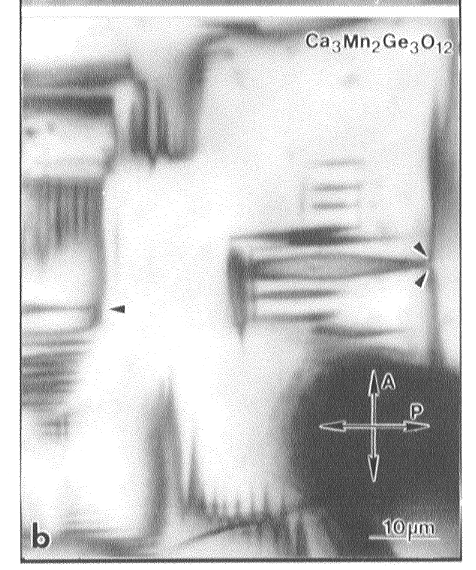

Ca3Mn2Ge3O12 garnet is tetragonal
at room temperature. The observed twinning of this garnet is similar to
the twinning in tetragonal majorite garnets. TEM examination of this tetragonal
Ca3Mn2Ge3O12 shows two kinds
of twins: a) Pseudomerohedral reflection twins with domain boundaries parallel
{101} and typical shapes of 90° corners and wedge-like needles (Fig.
3.3-10); b) Merohedral twins with coinciding lattices and curved domain
boundaries which do not have a preferred orientation. The merohedral twinning
indicates that the possible point group of Ca3Mn2Ge3O12
is 4, or 4/m only.
or 4/m only.
Due to the twin domains and the pseudo-cubic metric we combined synchrotron diffraction of a powder with diffraction of a twin-free (pseudomerohedral) single crystal for a study of tetragonal Ca3Mn2Ge3O12. The refinements show that the space group is I 41/a which is the same as in the tetragonal majorite garnets of the solid solution series majorite - pyrope. The tetragonal lattice constants are a=12.308 Å and c=12.323 Å. The tetragonal Ca3Mn2Ge3O12 structure is similar to the structure of the tetragonal majorite endmember Mg4Si4O12. Jahn-Teller elongated MnO6 octahedra build two sublattices similar to the MgO6 and SiO6 octahedra of the majorite endmember. The MnO6 octahedra at (0,0,0) and at (0,0,½) are elongated in different orientations. The I 41/a symmetry of Ca3Mn2Ge3O12 is due to the ordering of the elongated orientations of the octahedrons. This is in contrast to MgSiO3 majorite garnet in which the same symmetry reduction arises from ordering of Si and Mg on these same sites.
Heating experiments under a polarising microscope show that birefringent
tetragonal Ca3Mn2Ge3O12 crystals
transform reversibly to isotropic, hence cubic, Ca3Mn2Ge3O12
garnet at  235°C. This symmetry change
is an improper ferroelastic transition and similar to the symmetry change
that is inferred to occur in tetragonal majorite garnets at high pressures
and temperatures as a result of disordering of the Mg and Si atoms on the
octahedral sites of the structure. The twinning of Ca3Mn2Ge3O12
garnet is a transformation twinning which appears below the transition
temperature and is for this reason a direct observable model for the twinning
at the phase transition of tetragonal majorite-pyrope garnets. The pseudomerohedral
90°C twin corners in Ca3Mn2Ge3O12
garnet act as a precursor for interconnected needles. Below about 210°C
the twin microstructure shows no further changes and the 90° corners
as well as needles are frozen in (Fig. 3.3-10).
235°C. This symmetry change
is an improper ferroelastic transition and similar to the symmetry change
that is inferred to occur in tetragonal majorite garnets at high pressures
and temperatures as a result of disordering of the Mg and Si atoms on the
octahedral sites of the structure. The twinning of Ca3Mn2Ge3O12
garnet is a transformation twinning which appears below the transition
temperature and is for this reason a direct observable model for the twinning
at the phase transition of tetragonal majorite-pyrope garnets. The pseudomerohedral
90°C twin corners in Ca3Mn2Ge3O12
garnet act as a precursor for interconnected needles. Below about 210°C
the twin microstructure shows no further changes and the 90° corners
as well as needles are frozen in (Fig. 3.3-10).
 |
Fig. 3.3-10: Optical micrograph of pseudomerohedral phase transition twins in Ca3Mn2Ge3O12 garnet at room temperature showing the 90° corners (double arrows) and needles (arrow). A and P indicate the polarisation directions of analyser and polariser parallel to {101}. |

Tel: +49-(0) 921 55 3700 / 3766, Fax: +49-(0) 921 55 3769, E-mail: bayerisches.geoinstitut(at)uni-bayreuth.de
 Previous page
Previous page